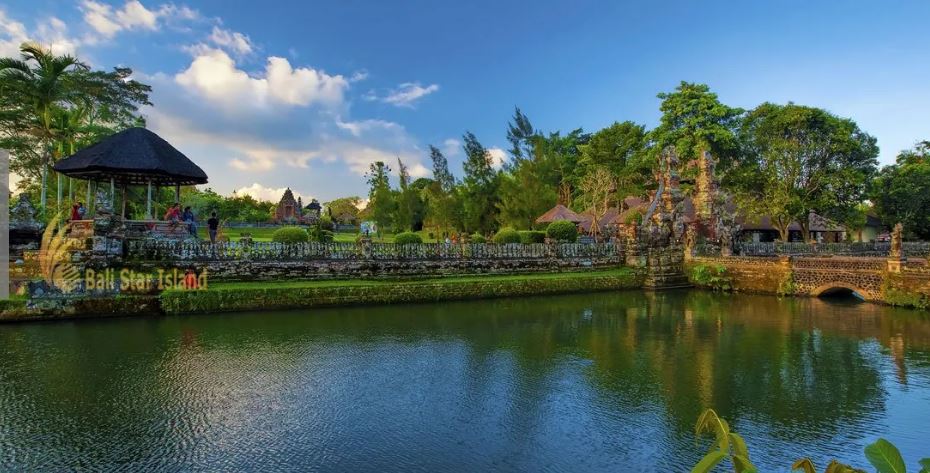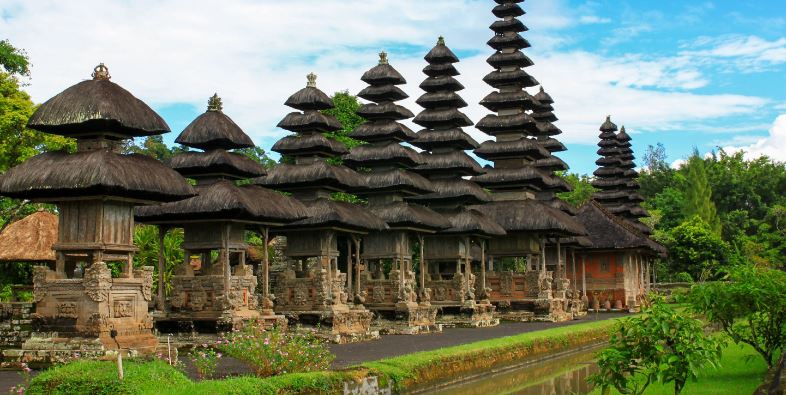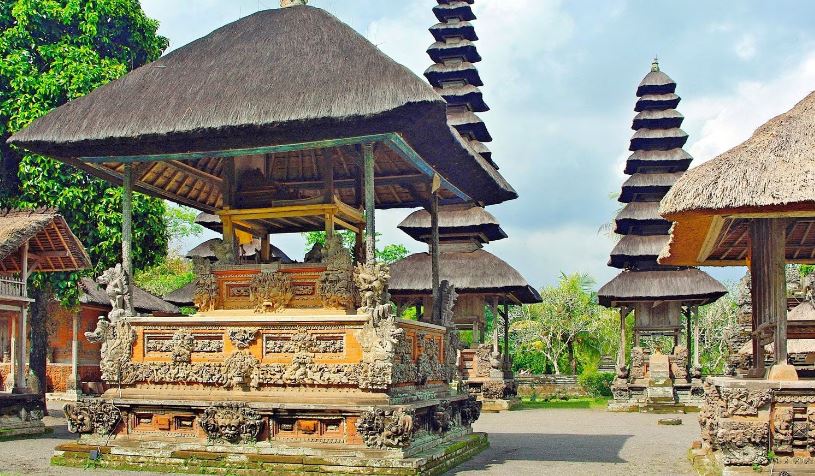Nestled in the heart of Mengwi, Bali, Taman Ayun Temple is a stunning 17th-century temple that blends history, spirituality, and breathtaking architecture. Surrounded by serene water gardens and intricate Balinese structures, it’s often referred to as one of Bali’s most beautiful temples.
Whether you’re a history enthusiast, spiritual traveler, or photography lover, this guide will help you discover everything about Taman Ayun Temple—from its fascinating history and architecture to entry fees, best visiting times, and travel tips.

🏛️ About Taman Ayun Temple
✔️ Location: Mengwi, Bali (~30 minutes from Ubud)
✔️ Founded In: 1634 by the Mengwi Kingdom
✔️ Significance: UNESCO-listed, historical royal family temple
✔️ Main Highlights: Pagoda-style shrines, lotus ponds, and intricate carvings
💡 Fun Fact: “Taman Ayun” translates to “Beautiful Garden”—a name that perfectly reflects its lush surroundings and water palace-like design.Architecture and Design:
The architecture of Taman Ayun Temple is a fine example of traditional Balinese temple design, characterized by intricately carved stone structures, towering pagodas, and ornate gateways. The temple complex is surrounded by a large moat, adding to its grandeur and beauty. Within the temple grounds, visitors can explore the central courtyard, which houses the main shrines and pavilions dedicated to various Hindu deities.

Cultural Significance:
Taman Ayun Temple holds significant religious and cultural importance for the Hindu community in Bali. It is dedicated to the worship of the Hindu trinity: Brahma, Vishnu, and Shiva, as well as other deities associated with Hindu mythology. The temple serves as a place of prayer, meditation, and spiritual reflection for worshippers and visitors alike
Best Time to Visit:
The best time to visit Taman Ayun Temple is during the early morning or late afternoon when the weather is cooler, and the temple grounds are less crowded. This allows visitors to explore the temple at their own pace and fully appreciate its beauty and tranquility.

📜 Temple History: The Royal Heritage of Taman Ayun
Built in 1634 by King Tjokerda Sakti Blambangan, Taman Ayun Temple was the spiritual and political heart of the Mengwi Kingdom. It served as a state temple, where the royal family worshiped ancestral deities and sought blessings for their reign.
The temple’s grandeur symbolized the kingdom’s wealth and power, making it a prestigious landmark of Balinese history. Even today, it remains one of Bali’s six most important temples, listed as a UNESCO World Heritage Site.
💡 Pro Tip: Hire a local guide to uncover the legends, rituals, and hidden meanings behind the temple’s intricate carvings!
🕰️ Best Time to Visit & Opening Hours
✔️ Best Time to Visit: Early Morning (8:00 AM – 10:00 AM) or Late Afternoon (4:00 PM – 6:00 PM)
✔️ Opening Hours: 9:00 AM – 5:00 PM daily
✔️ Temple Ceremonies: Best visited during Odalan Festival (occurs every 210 days according to the Balinese calendar)
💡 Why Visit Early? Avoid crowds, capture stunning sunrise photos, and experience the temple’s peaceful aura before tour groups arrive.
💰 Entry Fee & Costs
✔️ Adults: IDR 30,000 ($2 USD)$1 USD)
✔️ Children: IDR 15,000 (
✔️ Parking Fee: IDR 5,000 (~$0.35 USD)
💡 Pro Tip: Carry small cash in Indonesian Rupiah (IDR) for entry, as credit cards are not accepted.
👗 What to Wear When Visiting Taman Ayun Temple?
Since Taman Ayun is a sacred Hindu temple, visitors must dress respectfully.
✔️ Mandatory Attire:
- Sarong & Sash (provided at the entrance if needed)
- Knee-length skirts, pants, or dresses
- Covered shoulders (wear a t-shirt or scarf over tank tops)
🚫 Avoid: Short shorts, sleeveless tops, swimwear, or revealing outfits.
💡 Pro Tip: Bring a lightweight scarf or sarong in your bag—it’s useful for temple visits across Bali.
🏰 Architecture & Design: A Masterpiece of Balinese Temple Art
The Taman Ayun Temple complex is a perfect blend of spirituality and artistry, featuring:
✔️ Moat & Water Gardens – Symbolizing cosmic harmony in Hindu beliefs.
✔️ Multi-tiered Meru Towers – Each representing different Balinese deities.
✔️ Intricate Stone Gateways – Showcasing centuries-old Balinese craftsmanship.
✔️ Sacred Courtyards – Divided into three levels, leading to the main sanctuary.
💡 Photography Tip: The best shots can be taken from the raised viewing platform overlooking the entire temple complex! 📸
🎟️ Things to Expect During Your Visit
✔️ Serene Atmosphere – Unlike touristy temples like Tanah Lot, Taman Ayun is less crowded and perfect for meditation & peaceful walks.
✔️ Lush Tropical Gardens – Beautiful landscapes with lotus ponds & banyan trees.
✔️ Cultural Insights – Learn about Balinese Hinduism, temple offerings & rituals.
💡 Pro Tip: Bring mosquito repellent—the moat and water features attract mosquitoes, especially in the late afternoon.
🗺️ How to Get to Taman Ayun Temple
🚗 By Car: ~30 minutes from Ubud, ~45 minutes from Seminyak/Kuta
🏍️ By Scooter: Easy to reach via Jl. Raya Mengwi Road
🚕 By Private Driver: Best option (~IDR 500,000/day for car + driver)
💡 Pro Tip: Combine your trip with nearby attractions in West Bali!
🌍 Nearby Attractions: Must-Visit Places After Taman Ayun
1️⃣ Jatiluwih Rice Terraces (UNESCO Site, ~30 min drive)
2️⃣ Alas Kedaton Monkey Forest (Sacred monkey temple, ~15 min drive)
3️⃣ Tanah Lot Temple (Bali’s famous ocean temple, ~40 min drive)
4️⃣ Sangeh Monkey Forest (Lush jungle temple, ~25 min drive)
5️⃣ Bedugul Lake & Ulun Danu Temple (Iconic floating temple, ~1-hour drive)
💡 Pro Tip: Visit Taman Ayun in the morning, then explore Jatiluwih Rice Terraces for a scenic lunch with mountain views!
📌 Quick Review: Is Taman Ayun Worth Visiting?
✔️ YES, if you love:
✅ History & Culture – One of Bali’s most important royal temples.
✅ Tranquil Temples – Less touristy & perfect for peaceful exploration.
✅ Photography – Stunning architecture & lush gardens.
🚫 MAYBE NOT, if:
❌ You prefer dramatic ocean temples like Uluwatu or Tanah Lot.
❌ You’re short on time and only visiting major Bali attractions.
💡 Final Verdict: A hidden gem that’s 100% worth visiting, especially if you’re exploring Ubud or West Bali!
🛕 Final Thoughts: Why Taman Ayun Temple is a Must-See in Bali
✔️ One of Bali’s most beautiful temples, set in a peaceful water garden.
✔️ Less crowded & more serene compared to other famous temples.
✔️ Rich history & architecture that showcases Bali’s royal heritage.
✔️ Perfect for a cultural stop while exploring Ubud & West Bali.
If you’re looking for a historical, spiritual, and visually stunning temple experience in Bali, Taman Ayun should be on your itinerary!stament to the island’s enduring legacy as a center of Hindu spirituality and artistic expression. Whether you’re a history enthusiast, a culture lover, or simply seeking peace and serenity, Taman Ayun Temple is sure to leave a lasting impression on your Bali journey.

